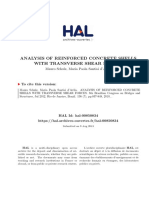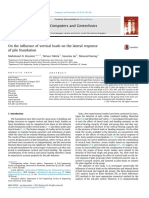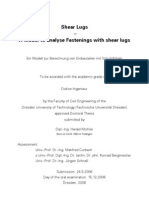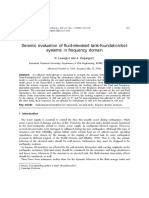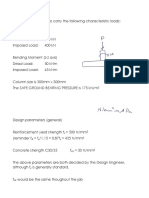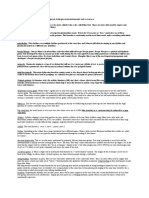A Numerical Study of Load Distribution of Pile Group Foundation by 2D Model
A Numerical Study of Load Distribution of Pile Group Foundation by 2D Model
Uploaded by
Sarah HaiderCopyright:
Available Formats
A Numerical Study of Load Distribution of Pile Group Foundation by 2D Model
A Numerical Study of Load Distribution of Pile Group Foundation by 2D Model
Uploaded by
Sarah HaiderCopyright
Available Formats
Share this document
Did you find this document useful?
Is this content inappropriate?
Copyright:
Available Formats
A Numerical Study of Load Distribution of Pile Group Foundation by 2D Model
A Numerical Study of Load Distribution of Pile Group Foundation by 2D Model
Uploaded by
Sarah HaiderCopyright:
Available Formats
See discussions, stats, and author profiles for this publication at: https://www.researchgate.
net/publication/304019697
A Numerical Study of Load Distribution of Pile Group Foundation by 2D Model
Article · August 2016
CITATIONS READS
5 2,829
3 authors, including:
Boonchai Ukritchon Suraparb Keawsawasvong
Chulalongkorn University Thammasat University
78 PUBLICATIONS 2,177 CITATIONS 223 PUBLICATIONS 2,616 CITATIONS
SEE PROFILE SEE PROFILE
Some of the authors of this publication are also working on these related projects:
Mechanisms of slope instability View project
Three-dimensional dynamic response of multilayered poroelastic media View project
All content following this page was uploaded by Suraparb Keawsawasvong on 21 June 2016.
The user has requested enhancement of the downloaded file.
http://wjst.wu.ac.th Engineering and Physical Sciences
A Numerical Study of Load Distribution of Pile Group Foundation by
2D Model
Boonchai UKRITCHON*, Janine FAUSTINO and Suraparb KEAWSAWASVONG
Department of Civil Engineering, Chulalongkorn University, Bangkok 10330, Thailand
(*Corresponding author’s e-mail: boonchai.uk@gmail.com)
Received: 11 June 2015, Revised: 26 October 2015, Accepted: 11 November 2015
Abstract
Studies about pile group foundation have been rapidly increasing in number over the past years.
However, past research works focused on pile settlement with consideration of a purely vertical load for
pile groups or pile raft foundations. There were few studies with an emphasis on pile load distribution of
pile group foundations together with a combined vertical load and a large overturning moment. For
example, the foundation of a wind turbine carries a large overturning moment and vertical forces at the
base of the structure. This paper presents a numerical study of load distribution of pile group foundations.
A 2D numerical model using finite element software, PLAXIS 2D, has been employed to analyze the
behavior of the pile group foundation. In the scope of analysis, pile group foundation consisting of large
numbers of regular grid piles with a cross section of the strip of the pile row can be analyzed with a 2D
model. For structural modeling, each pile is modeled as the embedded pile row. Modeling of pile group
foundation is achieved by creation of a small gap between the plate element of the pile cap and the
underlying soil, while the pile cap is rigidly connected with a small vertical plate segment which is hinged
at the top of the embedded pile row. Several parametric studies, including numbers of piles, overturning
moment ratios, stiffness of pile cap, and pile spacing, are also presented in this paper.
Keywords: Numerical analysis, pile group, finite element, load distribution
Introduction
In foundation design, shallow foundations are customarily considered first, to support structural
loads. If shallow foundations are not adequate, deep foundations are used instead, to utilize the bearing
capacity of stronger soil layers, which are normally located at deeper stratum. In most practical situations,
such as constructing large structures, piles are used in groups (pile group foundation). The layout can
come in any type of geometrical pattern (square, circle, rectangle, etc.) with spacing, S (center-to-center
distance between piles). Structural loads are transferred to the pile group by means of a pile cap, which is
connected to the head of each pile. When the pile group foundations are designed so that loadings are
transmitted to only piles, not underlying soil through contacted raft, the pile load distribution can be
calculated according to most foundation handbooks (e.g. Bowles [1]) as;
𝑃 𝑀𝑦 𝑥 𝑀 𝑦
𝐹𝑖 = 𝑁 ± ∑ 𝑥 2𝑖 + ∑ 𝑥𝑦 2𝑖 (1)
𝑖 𝑖
where P = vertical applied load
N = numbers of piles
Mx, My = moments about x axis and y axis, respectively
xi, yi = distances of the pile i from x axis and y axis and
Σxi2, Σyi2 = moment of inertia of the pile group about x axis and y axis, respectively
Walailak J Sci & Tech 2016; 13(8): 669-688.
Load Distribution of Pile Group Foundation Boonchai UKRITCHON et al.
http://wjst.wu.ac.th
Eq. (1) stems from the major assumptions: 1) the pile group foundation is modeled as a fully rigid
pile cap; 2) all piles are modeled as springs of the same stiffness; and 3) the base of the springs must be
fully rigid without any settlement, as shown in Figure 1. On the other hand, another type of analysis, the
flexible pile cap, may be adopted, by assuming that the pile cap may not behave rigidly, but depends on
its flexural stiffness, EI. Structural analysis, which considers both the cap stiffness and spring stiffness,
must be performed for this case. As a result, the pile load distribution of the flexible cap case may be
different from that of the rigid cap case.
Figure 1 Classical analysis of pile group foundation.
In reality, the settlement of a pile group is equal to the sum of the elastic shortening of the pile,
displacement due to shearing around the pile shaft, and displacement of the end bearing point, together
with some interaction effects between adjacent piles. The latter is called the pile group effect. Thus, pile
load distribution, individual pile settlement, and soil displacement must be analyzed, using such methods
as that of finite element, where 3D geometry of the problem, including the cap and geometrical position
of the pile, must be considered in the analysis.
However, there are some situations where analyses of the pile group can be approximated using a
2D finite element model, as shown in Figure 2. In this situation, the pile group foundation consists of so
many regular grid piles that the vertical cross section, considering the strip of pile row, can be analyzed
by a 2D model. In addition, loading conditions of the pile group may be a purely vertical load and/or
combined vertical load, with a uniaxial bending moment. More importantly, series of pile rows must be
modeled with a special element which allows soil to move around it, and not be constrained by plane
strain condition in the 2D model. Without this special element, the 2D modeled piles behave as
continuous walls and, thus, the approximation is not valid. Recently, PLAXIS 2D, (Brinkgreve [2]), the
finite element software, has developed this special element, called the embedded pile row, where 3D pile
group foundations can be approximated by 2D models, shown in Figure 2. Various researchers have
studied pile group foundations. However, most of them focused on the settlement of pile groups with
purely vertical loads. The case of pile load distribution in pile group foundations and combined vertical
loads and moments have been studied by very few. Thus, the aim of this paper is to study the pile group
foundation by approximation of the 2D finite element, together with an embedded pile row in PLAXIS
2D, in order to understand pile load distribution when subjected to combined vertical loads and large
overturning moments.
670 Walailak J Sci & Tech 2016; 13(8)
Load Distribution of Pile Group Foundation Boonchai UKRITCHON et al.
http://wjst.wu.ac.th
Figure 2 Pile group foundation studied by 2D model.
Some researchers have already used embedded pile rows to study pile group foundation. For
example, Engin et al. [6] studied the behavior of a single pile and pile group foundation using an
embedded pile row. It showed that it had similar behavior with the field test data, in both the compression
test and the pullout test. The influence of pile spacing was also observed in the behavior of the pile group,
in terms of a load-displacement curve. It was found that, as the spacing between piles increased, the load
that the pile group could carry to produce the same settlement also increased. This kind of numerical
analysis was also performed by Comodromos et al. [4]. Their results showed that, by decreasing the
spacing of the piles, the interaction between them increased; therefore the stiffness of each pile decreased.
In a study made by Lebeau [7], an embedded pile was used to analyze the influence of skin friction
distribution in the behavior of the pile raft foundation. The load-displacement curve was compared with a
pile raft foundation modeled under axisymmetric conditions. It was observed that the load-displacement
curves were reasonably close to each other.
Mandolini et al. [8] reviewed pile group behavior under vertical loads in terms of settlement, load
distribution, and bearing capacity, through monitoring full scale structures and experimental researches.
They concluded that the use of classical methods for foundation design, which was used in practice, was
not suitable for a proper design, and needed to be revised. Comodromos et al. [5] optimized a foundation
design for a bridge, based on both experimental data and non-linear 3D analysis. They analyzed the
relationship of load distribution with settlement and throughout the length of the piles, for 2×2 and 3×3
pile group arrangements.
The behavior of the pile group foundation can also be evaluated when it is subjected to excavation-
induced soil movement. Analyzing 4-pile groups connected to a pile cap with different rigidity from
centrifuge model tests, Choudhury et al. [3] concluded that, for a rigid pile cap, the maximum negative
bending moment was developed at the head of the pile, and was larger compared to a flexible cap.
Furthermore, larger pile head deflection was observed in the pile group with a flexible pile cap, compared
to a similar pile group with a rigid pile cap. Very recently, several researchers have performed numerical
analyses of modelling of pile group foundations using the adaptive generated mesh approach, including
Ninić et al. [10], Das and Mehrmann [11], Das [12], Das and Natesan [13], and Mortie [14].
The behavior of pile groups are frequently described by means of load-displacement curves. Only a
few have studied the effect of load distribution on the pile group. Those who studied load distribution
correlated it with the settlement (Comodromos et al. [5]), throughout the pile length (Comodromos et al.
[5] and Comodromos et al. [4]), and the pile diameter (Mandolini et al. [8]). In this paper, the relationship
between load and pile location is considered. There are very few researches which have studied load
distribution of the pile group subjected to a combined vertical load and large moment.
The objective of this paper is to present a 2D finite element analysis of the pile load distribution
behavior of a pile group foundation modeled by embedded pile row. The behavior of a single pile case is
first analyzed, followed by studying the behavior of the pile group. The load distribution of the pile
Walailak J Sci & Tech 2016; 13(8) 671
Load Distribution of Pile Group Foundation Boonchai UKRITCHON et al.
http://wjst.wu.ac.th
group, using finite element analysis and classical static method, is also compared. Parametric studies are
also performed to analyze the influence of the number of piles, loading condition, pile spacing, and
rigidity of the pile cap, on the behavior of the pile group.
Materials and methods
Site classification
The soil profile considered in this study is located in Nakhon Si Thammarat province, a southern
city of Thailand. Based on the soil report for the construction site of the pile group foundation in this
province, it is composed of a clay layer, subdivided into 4 general types, as shown in Figure 3. The first
layer is classified as very soft clay, where its undrained shear strength, su, and Young’s modulus, Eu,
increases linearly from elevation 0m to elevation −15m. The second layer is composed of medium stiff
clay, which is from elevation −15 to −20 m. From elevation −20 to −27 m, the soil stratum is made up of
stiff clay. The last layer is from elevation −27 to −35 m, classified as hard clay. The second to fourth
layers have constant undrained shear strength, su, and Young’s modulus, Eu, with different magnitudes.
The ground water level (G.W.L.) is located 1.50 m below the ground surface. For this study, the pile tip is
designed to be located in the hard clay (elevation −27 m). The properties of the soil profile will be
presented in subsequent sections of the paper.
Figure 3 Soil profile of the selected site.
672 Walailak J Sci & Tech 2016; 13(8)
Load Distribution of Pile Group Foundation Boonchai UKRITCHON et al.
http://wjst.wu.ac.th
Characteristics of 2D finite element model
In this study, a simplified 2D analysis of the pile group foundation is used by considering the cross
section of a strip of pile row, as shown in Figure 2. In order to analyze the behavior of the single pile and
pile group, subjected to vertical and overturning moment, the finite element software, PLAXIS 2D
(Brinkgreve [2]), is used. The finite element analysis is performed under 2 dimensional plane strain
conditions. This model is used for geometries with (more or less) the same cross-section and
corresponding stress state and loading scheme over a certain length perpendicular to the cross-section (z-
direction) 2D (Brinkgreve [2]).
1. Geometry model
Figures 4 and 5 show the geometry model of the single pile and the pile group foundation,
respectively. In the case of single pile, the geometry of the numerical model consists of 2 material
components: 1) soil elements; and 2) a single embedded pile row. However, for the case of the pile group,
the geometry of the numerical model consists of 4 material components: 1) soil elements; 2) a series of
embedded pile rows; 3) small vertical pile plate elements; and 4) a plate element for the pile cap. In this
case, the plate pile cap and the underlying soil are modeled to have a small gap (0.1 m) between them, in
order to simulate the model as the pile group foundation, as shown in Figure 6. This modeling is to avoid
load transfer from the pile cap to the underlying soil. Without this small gap, the behavior of the problem
affects the pile raft foundation, where all applied loads are shared by the underlying soil and piles. With
this small gap, the vertical load and overturning moment applied to the pile cap are transferred only to the
pile group, without any load sharing of the underlying soils. To model the pile group foundation, a
vertical pile plate element connecting the embedded pile row and the plate element of the pile cap is
created. It should be noted that the vertical plate segments are set to be weightless, in order to not add any
vertical loading to the pile. The connection between the vertical plate and the embedded pile row is a
hinged connection, in order to allow only the vertical load transfer from the cap to the embedded pile row,
without transferring a bending moment. However, the connection between the vertical plate and the plate
pile cap is fully fixed, in order to have an adequate degree of freedom in the entire stable system.
Figure 4 Finite element model of single pile.
Walailak J Sci & Tech 2016; 13(8) 673
Load Distribution of Pile Group Foundation Boonchai UKRITCHON et al.
http://wjst.wu.ac.th
(a) (b) (c)
Figure 5 Finite element model of pile group with 3B pile spacing (a) 8×1, (b) 9×1, and (c) 10×1.
(a)
(b)
(c)
Figure 6 Modeling techniques for connection between piles and pile caps of (a) 8×1, (b) 9×1, and (c)
10×1 pile group.
2. Element types
The 15-node triangular elements with 12 stress points are used to model the soil layers. The pile cap
and vertical piles connecting the pile cap and each individual embedded pile row are modeled using a
plate element with 3 degrees of freedom per node: 2 translational degrees of freedom (ux and uy), and one
rotational degrees of freedom perpendicular to the cross-section (θz). Parametric studies are also
674 Walailak J Sci & Tech 2016; 13(8)
Load Distribution of Pile Group Foundation Boonchai UKRITCHON et al.
http://wjst.wu.ac.th
performed on pile cap thickness. Two thicknesses were selected, 1.8 and 2.0 m. Table 2 displays the
values for the axial stiffness, EA, and flexural rigidity, EI, for the respective thicknesses.
The pile rows are modeled using the special element, called the embedded pile row, developed by
Sluis [9]. Using this element means that the piles are not ‘in’ the 2D model, but superimposed ‘on’ the
mesh while the soil element is still continuous. Figure 7 shows the interaction between the embedded pile
row and surrounding soil. The interaction between the embedded pile row and adjacent soil is modeled by
the special interface element, which is automatically added around the embedded pile row. Its behavior is
of the elastic-plastic Mohr-Coulomb model of the adjacent soil. More details of the embedded pile row
can be found in Sluis [9] and Brinkgreve [2].
3. Material properties
The constitutive model used for the soil is the Mohr-Coulomb material in an undrained condition.
The elastic isotropic material type is applied for both plate elements of the pile caps and small vertical
pile plate elements. A summary of the properties is shown in Tables 1 - 3. In this study, the weight of the
plate elements of the pile caps is assumed to be zero, but their weight effects are considered by adding
their weight to the total vertical applied loads. Generally, the interface roughness (Rinter) between piles
and soil ranges between 0.5 - 0.95, depending on the undrained shear strength of the clay. Since there is
no existing data of the interface roughness in this area, the standard value of interface roughness is chosen
to be 0.67, according to the typical value used in the standard practice of pile foundation. It should be
noted that the undrained (B) denotes the effective stress analysis of the finite element simulation using the
undrained strength parameters, namely c = su, φ = 0, ψ = 0, where c = cohesion, su = undrained shear
strength, φ = total friction angle, and ψ = total dilation angle.
Table 1 Material properties of soil.
Parameter Symbol (unit) Soft clay Medium stiff clay Stiff clay Hard clay
Mohr-
Material model Model Mohr-Coulomb Mohr-Coulomb Mohr-Coulomb
Coulomb
Type of material behavior Type Undrained (B) Undrained (B) Undrained (B) Undrained (B)
Soil unit weight above
γunsat (kN/m3) 15.93 15.3 19.3 17.73
phreatic level
Soil unit weight below
γsat (kN/m3) 15.93 15.3 19.3 17.73
phreatic level
2
Undrained shear strength su,ref (kN/m ) 10 60 115 125
E'/su,ref 100 250 400 500
Young's modulus E' (kN/m2) 1000 15000 46000 62500
Friction angle φ' (°) 0 0 0 0
Dilatancy angle ψ (°) 0 0 0 0
Young's modulus inc. E'inc (kN/m2) 66.67 - - -
Reference level yref (m) 0 - - -
Undrained shear strength 2
su,inc (kN/m ) 0.67 - - -
inc.
Reference level yref (m) 0 - - -
Poisson's ratio ν' 0.35 0.35 0.35 0.35
Strength reduction factor Rinter 0.67 0.67 0.67 0.67
Walailak J Sci & Tech 2016; 13(8) 675
Load Distribution of Pile Group Foundation Boonchai UKRITCHON et al.
http://wjst.wu.ac.th
Table 2 Material properties for plate elements of pile caps and vertical pile plate elements.
Parameter Symbol Pile cap Vertical pile plate Unit
Material model Type Elastic, isotropic Elastic, isotropic -
4.58 × 107
Normal stiffness EA 3.39 × 106 kN/m
5.09 × 107
1.24 × 107
Flexural rigidity EI 4.52 × 107 kNm2/m
1.07 × 107
Weight w - - kN/m/m
Poisson’s ratio ν 0.2 0.2 -
Table 3 Material properties of embedded pile rows.
Parameter Symbol Soft clay Unit
Young's modulus E 2.54 × 107 kN/m2
Unit weight γ 24 kN/m3
Pre-defined massive
Pile type - -
square pile
Width B 0.4 m
Spacing of the piles in the out-of- 1.2
Lspacing m
plane direction 1.5
Skin resistance at the pile bottom Tbot, max 0 kN/m
Skin resistance at the pile top Ttop, max 100 kN/m
End-bearing resistance Fmax 237.7 kN
676 Walailak J Sci & Tech 2016; 13(8)
Load Distribution of Pile Group Foundation Boonchai UKRITCHON et al.
http://wjst.wu.ac.th
Figure 7 Interaction between soil and embedded pile (Sluis [9]).
4. Parametric studies
Five parametric studies included: 1) a single pile row; 2) multiple pile rows, or a number of piles
rows; 3) moment ratios; 4) pile cap stiffness; and 5) pile spacing. The first analysis is of a single pile row
without a pile cap, where the load is directly applied to the pile, as shown in Figure 4. The second
parametric analyses correspond to a pile group consisting of multiple embedded pile rows, having 3
cases: 8×1, 9×1, and 10×1 groups. The third parametric studies consider a purely vertical load and a
vertical load with a large overturning moment of 2 ratios applied at the center of the plate element of the
pile cap. The fourth parametric study is a variation of pile cap stiffness, where 2 thicknesses are selected,
1.8 and 2.0 m. The last parametric analyses consider 2 ratios of pile spacing: 3.0 and 3.75 times the
square pile size, B. Figure 5 shows the arrangement of 3 pile group cases with 3.0B spacing.
5. Boundary condition and mesh generation
Standard fixity (fixed and roller) boundary conditions are used in the model. To optimize the
accuracy and the amount of time required to calculate the load steps, the global coarseness was set to
medium mesh refinement. Figure 8 shows an example of mesh generation for the case of a single pile
row and multiple pile rows having coarseness of medium mesh.
Walailak J Sci & Tech 2016; 13(8) 677
Load Distribution of Pile Group Foundation Boonchai UKRITCHON et al.
http://wjst.wu.ac.th
(a) (b)
Figure 8 Mesh generation of pile group having coarseness of medium mesh; (a) single pile row and (b)
9×1.
Static calculation of pile capacity
As shown in Figure 9, the ultimate bearing capacity of an individual pile can be calculated as;
Qult = Qs + QE - Wp (2)
where, Qult = ultimate pile capacity
Qs = ultimate skin resistance of pile = RintersuPL,
QE = ultimate end bearing resistance of pile = (9su+σv0)A
Wp = weight of the pile
P, L = pile perimeter and length, respectively
A = area of pile
σv0 = total overburden pressure at pile tip
Figure 9 Static calculation of single pile capacity.
678 Walailak J Sci & Tech 2016; 13(8)
Load Distribution of Pile Group Foundation Boonchai UKRITCHON et al.
http://wjst.wu.ac.th
The allowable bearing capacity, Qall, is computed by dividing the sum of skin resistance, Qs, and
end bearing resistance, QE, by the factor of safety, FS, which is 2.5, then subtracting it by the weight of
the pile, Wp. Table 4 summarizes the computed values of pile capacity. In comparing results obtained
from this study, the allowable bearing capacity is divided by the out-of-plane spacing of the embedded
pile row, S = 1.20 m, which makes the value of the allowable bearing capacity, Qall = 442 kN/m. It should
be noted that the pile length of 27 m was chosen based on the result of the allowable pile capacity using
the static method with a factor of safety of 2.5.
Table 4 Pile capacity calculation for pile spacing of 1.20 m.
Skin resistance, End-bearing Weight, Ultimate pile
QE/S Qult/S Qall/S
QS (kN) resistance, QE (kN) W (kN) capacity, Qult (kN)
1345 238 104 1479 198.3 1233 442
Moment ratios
There are 3 loading conditions simulated in this study: M/P = 0, M/P = 2.4 and M/P = 2.6. The 2
cases of combined vertical load and moment correspond to some structures of pile group foundation
subjected to a very large overturning moment. It should be noted that the maximum computed force of all
embedded pile rows, Fmax, under the serviceability condition, must be less than the allowable pile capacity
calculated by the static method. Otherwise, the design input conditions are not valid.
Results and discussion
Single pile case
1. Serviceability state
The behavior of a single pile under the serviceability state is first analyzed. Figure 10a shows the
deformed mesh of this analysis, where a high degree of shearing happens at the pile-soil interface. It can
be observed in Figure 10b that, at the serviceability state, the shear stresses are first mobilized at the tip
of the pile. A relationship between loads applied in the pile until allowable pile capacity and their
corresponding displacement is shown in Figure 11. As expected, a linear relationship is observed because
of the elastic theory. From the graph, the equivalent pile spring stiffness (ks,eq) of the single pile row case
can be obtained as: ks,eq = 63.7×103 kN/m.
Walailak J Sci & Tech 2016; 13(8) 679
Load Distribution of Pile Group Foundation Boonchai UKRITCHON et al.
http://wjst.wu.ac.th
(a) (b)
Figure 10 Results of single pile at serviceability state; (a) deformed mesh and (b) relative shear stress.
Figure 11 Load-displacement curve of single pile under serviceability state.
2. Limit state of ultimate pile capacity
The behavior of a single pile in the limit state is next examined. Figure 12a shows the deformed
mesh of this analysis, where complete slippage can be observed at the pile-soil interface. As shown in
Figure 12b, shear tractions are fully mobilized along the pile length. Similarly, the end bearing stresses
underneath the pile are also fully mobilized at its tip. The load-displacement curve is shown in Figure 13,
indicating that the limit state is successfully solved and reached the convergence. From this figure, the
ultimate capacity of a single pile from the analysis is: Pult/S = Mstage × Pinput = 0.6209 × 2000 kN/m = 1242
kN/m. The reported value of end bearing force, QE/S = 198.1 kN/m. It can be seen that the computed
values of Pult/S and QE/S match very well with those calculated from the static method in Table 4.
Therefore, these results indicate that the behavior of single pile rows can be analyzed correctly and
accurately at the limit state.
680 Walailak J Sci & Tech 2016; 13(8)
Load Distribution of Pile Group Foundation Boonchai UKRITCHON et al.
http://wjst.wu.ac.th
(a) (b) (c)
Figure 12 Results of single pile at limit state; (a) deformed mesh, (b) relative shear stress, and (c) axial
force.
0.6209
Figure 13 Load-displacement curve of single pile row analysis.
Pile group case
1. Purely vertical load
The base case corresponds to the pile group consisting of pile row 9×1, pile spacing of S = 3B =
1.20 m, and pile cap thickness of 1.8 m. Figure 14 shows the results of a purely vertical load case. It can
be observed that principal effective stress, σ′1, and relative shear stress, τrel, are high at the corner piles
and at the tip of the pile group. Due to small pile spacing, the soils between piles may have difficulties in
moving; hence, the skin capacity of the pile is mainly contributed by the corner piles, which is found to be
the same as the result of Engin et al. [6]. It should be noted that the load distribution is symmetrical with
respect to the center of the pile group.
Walailak J Sci & Tech 2016; 13(8) 681
Load Distribution of Pile Group Foundation Boonchai UKRITCHON et al.
http://wjst.wu.ac.th
(a) (b) (c)
Figure 14 Results of vertical load of pile group foundation; (a) deformed mesh, (b) principal effective
stress, σ’1, and (c) relative shear stress, τrel.
The behavior of the load distribution is analyzed by considering 3 normalized plots, as shown in
Figure 15. For all subplots, the horizontal axis represents the x-position of each pile, xi, divided by the
maximum position, xmax, of the exterior pile of the group, giving rise to a range of −1.0 to 1.0. Figure 15a
shows the distribution of the pile load, Fi, normalized by the maximum computed pile load, Fmax. Figure
15b show the plot of normalized equivalent pile spring stiffness, ki,eq/ks,eq, where ki,eq = Fi/∆i; ∆i =
settlement of pile i at its top, and ks,eq = 63.7×103 kN/m, according to a serviceability state analysis of the
single pile row. Lastly, Figure 15c shows the normalized settlement profile of the pile cap. It can be seen
from those figures that this pile group behaves as if the pile cap is flexible, even though the stiffness of
the pile cap is based on 1.8 m. thickness. This result is in contrast to the classical calculation of pile load
distribution based on Eq. (1), where all piles carry the same compression load and the pile cap is assumed
to be rigid. However, Figure 15a shows that the largest pile force is found at the corner piles, while the
smallest pile force occurs at the middle pile cap, just below the applied vertical load. Figure 15b indicates
that the classical assumption of all constant values of equivalent spring stiffness is no longer valid. Each
pile behaves as if it has different equivalent spring stiffness, where central piles have softer spring
stiffness, but corner piles have stiffer stiffness. Thus, the softer central spring results in larger pile cap
settlement, while the stiffer corner spring gives rise to less settlement, as shown in Figure 15c. The
behavior of the pile group in terms of pile load distribution and equivalent stiffness can be best fitted by a
polynomial pattern to the fourth (4th) degree. On the other hand, settlement pattern has a polynomial
pattern to the second (2nd) degree.
682 Walailak J Sci & Tech 2016; 13(8)
Load Distribution of Pile Group Foundation Boonchai UKRITCHON et al.
http://wjst.wu.ac.th
1.40
1.20
1.20
1.00
1.00
ki,eq/ks,eq
0.80
Fi/Fmax
0.80
0.60 0.60
Actual 0.40 y = 0.46x4 - 0.05x2 + 0.60 0.40
Classical R² = 1.00 y = 0.57x4 + 0.10x2 + 0.55
0.20 0.20 R² = 1.00
0.00 0.00
-1.5 -1 -0.5 0 0.5 1 1.5 -1.5 -0.5 0.5 1.5
xi/xmax xi/xmax
(a) (b)
1.20
1.00
0.80
Δi/Δmax
0.60
y = -0.24x2 + 0.98
0.40 R² = 0.98
0.20
0.00
-1.5 -0.5 0.5 1.5
xi/xmax
(c)
Figure 15 Effect of axial load applied to a pile group of 9 piles; (a) normalized pile load distribution, (b)
equivalent pile stiffness, ki,eq, and (c) normalized settlement profile.
2. Combined axial load and overturning moment
When the pile group is subjected to a combined axial load and an overturning moment, a change in
load distribution is observed. In Figures 16b and 16c, the principal effective stress and relative shear
stress are concentrated at the overturning side. It can be observed that piles near the side where moment
was applied experience larger principal effective stress and shear stress compared to other piles. In
Figures 17a and 17b, larger pile force and settlement are found at the overturning side. Due to a
combined axial load and overturning moment, all the piles in the group experience compression.
According to the classical calculation in Eq. (1), the load distribution on each pile row is linear, while the
behavior for the numerical analysis is polynomial, to the 4th degree. It can be seen that the largest pile
load happened at the exterior pile of the same direction of the overturning moment. Comparison of the
largest pile load, Fmax between finite element analysis and the classical calculation is made as follows:
Finite element, Fmax/P = 0.33, vs. Classical analysis, Fmax/P = 0.24. It can be clearly seen that using the
classical analysis of pile load distribution in Eq. (1) can lead to non-conservative determination of pile
force, where some of the pile forces are larger than the allowable capacity. Otherwise, more numbers of
piles are required in order to make the design valid. Modeling the accurate behavior of load distribution is
important in designing pile groups, since it can lead to overestimation of allowable pile capacity,
indicating the design is not valid. As shown in Figure 17b, a pile cap settlement profile can be
approximated by 2nd order polynomial expression. Again, the classical assumption of a pile cap moving
rigidly is no longer valid.
Walailak J Sci & Tech 2016; 13(8) 683
Load Distribution of Pile Group Foundation Boonchai UKRITCHON et al.
http://wjst.wu.ac.th
(a) (b) (c)
Figure 16 Results of combined axial load and moment of pile group foundation; (a) deformed mesh, (b)
principal effective stress, σ′1, and (c) relative shear stress, τrel.
1.20 1.50
y = 0.29x4 + 0.01x2
1.00
+ 0.24x + 0.24 1.00
R² = 1.00 0.80
Δi/Δmax
Fi/Fmax
0.60
0.50
0.40 y = -0.11x2 + 0.66x + 0.46
Actual
0.20 R² = 1.00
Classical 0.00
0.00 -1.5 -1 -0.5 0 0.5 1 1.5
-1.5 -1 -0.5 -0.20 0 0.5 1 1.5
-0.50
xi/xmax xi/xmax
(a) (b)
Figure 17 Effect of combined axial load and moment applied to the pile group; (a) normalized pile load
distribution and (b) normalized settlement profile.
Parametric studies on pile group
1. Moment ratios applied to the pile group (M/P)
Parametric analyses are also conducted to examine the consequences of the influence of different
factor, namely moment ratios, number of piles, pile cap thickness, and pile spacing on the pile load
distribution and settlement profile of the cap. For a typical case with 9 numbers of piles, pile spacing, S =
3B = 1.20 m, and pile cap thickness of 1.8 m, 2 moment ratios, M/P = 2.4 and 2.6, are investigated. It can
be seen from Figure 18 that the pile force distribution and settlement profile can be uniquely normalized
with the same trend and with very small differences in the 2 curves.
684 Walailak J Sci & Tech 2016; 13(8)
Load Distribution of Pile Group Foundation Boonchai UKRITCHON et al.
http://wjst.wu.ac.th
1.20
1.50
M/P=2.4 1.00
M/P=2.6 0.80 1.00
Fi/Fmax
Δi/Δmax
0.60
M/P=2.4
0.50
0.40 M/P=2.6
0.20 0.00
0.00 -1.5 -1 -0.5 0 0.5 1 1.5
-1.5 -0.5 0.5 1.5 -0.50
xi/xmax xi/xmax
(a) (b)
Figure 18 Influence of moment ratio; (a) normalized pile load distribution and (b) normalized settlement
profile.
2. Number of piles
Three configurations are also analyzed in this study: 8×1, 9×1, and 10×1 pile groups. Figure 19 and
20 show results of analyses regarding normalized pile load distribution and a normalized settlement
profile of the cap. Generally, curves of normalized pile load distribution and settlement profiles are not
perfectly unique, with small differences observed. The case of a purely vertical load shows larger
differences of curves than those of a vertical load with a large moment.
1.20 1.20
8 piles
9 piles 1.00 1.00
10 piles 0.80 0.80
Fi/Fmax
Fi/Fmax
0.60 0.60
0.40 8 piles
0.40
9 piles
0.20 0.20 10 piles
0.00 0.00
-1.5 -1 -0.5 0 0.5 1 1.5 -1.5 -0.5 0.5 1.5
xi/xmax xi/xmax
(a) (b)
Figure 19 Influence of number of piles on the normalized pile load distribution; (a) combined axial load
and moment case and (b) axial load case.
1.20
1.20
8 piles 1.00
0.80 1.00
9 piles
0.60 0.80
10 piles
Δi/Δmax
Δi/Δmax
0.40
0.60
0.20 8 piles
0.00 0.40
9 piles
-1.5 -1 -0.5 -0.20 0 0.5 1 1.5 0.20
-0.40
10 piles
0.00
-0.60 -1.5 -1 -0.5 0 0.5 1 1.5
xi/xmax xi/xmax
(a) (b)
Figure 20 Influence of number of piles to the normalized settlement profile; (a) combined axial load and
moment case and (b) axial load case.
Walailak J Sci & Tech 2016; 13(8) 685
Load Distribution of Pile Group Foundation Boonchai UKRITCHON et al.
http://wjst.wu.ac.th
3. Pile cap thickness
There are 2 pile cap thicknesses considered in this study: 1.8 and 2 m. When the thickness varies,
the flexural rigidity of the plate element of the pile cap, EI, changes accordingly. A larger pile cap
thickness creates a more rigid pile cap. Figure 21 summarizes the results of pile cap thickness effect.
Generally, the curves of the pile load distribution and pile cap settlement were uniquely normalized for 2
different thickness cases.
thickness = 2m 1.20 1.20 thickeness = 2m
1.00 thickness = 1.8m
1.00
thickness = 1.8m
0.80
0.80
Fi/Fmax
0.60
Δi/Δmax
0.60 0.40
0.40 0.20
0.00
0.20
-1.5 -1 -0.5 -0.20 0 0.5 1 1.5
0.00
-0.40
-1.5 -1 -0.5
xi/x0max 0.5 1 1.5
xi/xmax
(a) (b)
Figure 21 Influence of pile cap thickness; (a) normalized pile load distribution and (b) normalized
settlement profile.
4. Spacing of piles
The last parametric analyses focus on the influence of the pile spacing on the behavior of the pile
group. In Figure 22, it can be observed that larger pile forces are developed at intermediate piles by
increasing the spacing between piles. The effect of pile spacing is more significant than other parameters,
as described earlier. In general, the curves of the pile load distribution and the settlement profile of the
cap cannot be uniquely normalized. However, when the pile group is subjected to a combined vertical
load and moment, the pile spacing does not affect the behavior of the settlement.
1.2 1.2
1.0 1.0
0.8 0.8
Fi/Fmax
Fi/Fmax
0.6 0.6
0.4 0.4
s=1.2m
s=1.2m
0.2 s=1.5m 0.2
s=1.5m
0.0 0.0
-1.5 -1 -0.5 0 0.5 1 1.5 -1.5 -1 -0.5 0 0.5 1 1.5
xi/xmax xi/xmax
(a) (b)
Figure 22 Influence of spacing of piles on the normalized pile load distribution; (a) axial load case and
(b) combined axial load and moment case.
686 Walailak J Sci & Tech 2016; 13(8)
Load Distribution of Pile Group Foundation Boonchai UKRITCHON et al.
http://wjst.wu.ac.th
1.20 1.20
1.00 1.00
0.80
0.80 0.60
Δi/Δmax
Δi/Δmax
0.60 0.40 s=1.2m
0.20
0.40 s=1.5m
0.00
s=1.2m
0.20 -1.5 -1 -0.5 -0.20 0 0.5 1 1.5
s=1.5m
-0.40
0.00
-1.5 -1 -0.5 0 0.5 1 1.5 -0.60
xi/xmax xi/xmax
(a) (b)
Figure 23 Influence of spacing of piles on the normalized settlement profile; (a) axial load case and (b)
combined axial load and moment case.
Conclusions
This paper presents numerical investigations of 2D modeling of a single pile row and multiple pile
rows of pile group foundations by 2 dimensional plane strain finite element analysis, together with an
embedded pile row element. It is concluded that the use of a single pile row model to describe the
behavior at the limit state is accurate and comparable to the static method. For cases of vertical load and
combined vertical load and a large overturning moment, the load distribution behaviors of the pile group
are found to be different, compared to those of rigid pile cap assumption. The present classical method
predicting the behavior of the pile group foundation may not be sufficient, as this method can predict pile
loads smaller than those of more realistic analyses, such as finite element methods. For a purely vertical
load case, the behavior of the normalized pile load distribution and equivalent pile spring stiffness can be
best fitted by a 4th degree polynomial expression, while the normalized settlement profile of the pile cap is
well approximated by a 2nd degree polynomial pattern. Moreover, individual piles developed different
equivalent spring stiffness, whereas intermediate piles behaved as soft springs and corner piles behaved as
stiff springs. For a combined vertical load and moment case, the curves of pile load distribution and
settlement of pile cap are quite unique, with some minor differences in different parameters of number of
piles, stiffness of pile cap, and moment ratios. However, pile spacing is the most significant parameter,
where pile load distribution does not turn out to be a unique curve.
References
[1] JE Bowles. Foundation Analysis and Design. McGraw-Hill, Singapore, 1988.
[2] RBJ Brinkgreve. Plaxis 2D 2012 Manual. A.A. Balkema Publishers, Netherlands, 2012.
[3] D Choudhury, RF Shen and CF Leung. Centrifuge Model Study of Pile Group Subject to Adjacent
Excavation. GeoCongress, Louisiana, United States, 2008, p. 141-8.
[4] EM Comodromos, CT Anagnostopoulos and MK Georgiadis. Assessment of axial pile group
response based on load test. Comput. Geotech. 2003; 30, 505-15.
[5] EM Comodromos, MC Papadopoulou and IK Rentzeperis. Pile foundation analysis and design
using experimental data and 3-D numerical analysis. Comput. Geotech. 2009; 36, 819-36.
[6] HK Engin, EG Septanika and RBJ Brinkgreve. Estimation of pile group behavior using embedded
piles. In: Proceeding of the 12th International Conference of International Association for Computer
Methods and Advances in Geomechanics, Goa, India, 2008, p. 3231-8.
[7] FE-Analysis of Piled and Piled Raft Foundations, Available: http://kb.plaxis.nl/sites/kb.plaxis.nl/
files/kbpublications/tschuchnigg_lebeau_validation_emb_pile.pdf, accessed July 2015.
Walailak J Sci & Tech 2016; 13(8) 687
Load Distribution of Pile Group Foundation Boonchai UKRITCHON et al.
http://wjst.wu.ac.th
[8] A Mandolini, G Russo and C Viggiani. Pile foundations: Experimental investigations, analysis and
design. In: Proceeding of the 16th International Conference on Soil Mechanics and Geotechnical
Engineering, Osaka, Japan, 2005, p. 177-213.
[9] J Sluis. Validation of Embedded Pile Row in Plaxis 2D, Available:
http://kb.plaxis.com/publications/validation-and-application-embedded-pile-row-feature-plaxis-2d,
accessed October 2015.
[10] J Ninić, J Stascheit and G Meschke. Beam-solid contact formulation for finite element analysis of
pile-soil interaction with arbitrary discretization. Int. J. Numer. Anal. Meth. Geomech. 2014; 38,
1453-76.
[11] P Das and V Mehrmann. Numerical solution of singularly perturbed convection-diffusion-reaction
problems with two small parameters. BIT Numer. Math. 2016; 56, 51-76.
[12] P Das. Comparison of a priori and a posteriori meshes for singularly perturbed nonlinear
parameterized problems. J. Comput. Appl. Math. 2015; 290, 16-25.
[13] P Das and S Natesan. Richardson extrapolation method for singularly perturbed convection-
diffusion problems on adaptively generated mesh. Comput. Model. Eng. Sci. 2013; 90, 463-85.
[14] I Mortie. 2014, Numerical Analysis of Slope Stability Reinforced by Piles in Over-Consolidated
Clay. Master Dissertation. Ghent University, Belgium.
688 Walailak J Sci & Tech 2016; 13(8)
View publication stats
You might also like
- Holy Musical B@Man ScriptDocument106 pagesHoly Musical B@Man ScriptSaraya Danielsen100% (3)
- Organizational Assessment Simulation Analysis Ogl 357Document2 pagesOrganizational Assessment Simulation Analysis Ogl 357api-538762494No ratings yet
- CRBV Kohler Case - Group 6Document14 pagesCRBV Kohler Case - Group 6amitsuchi100% (4)
- Asset Management PAS 55 ISO 55000Document15 pagesAsset Management PAS 55 ISO 55000Prathap Selvam100% (1)
- Mr. Jones Bipolar Disorder Case StudyDocument3 pagesMr. Jones Bipolar Disorder Case StudyCamille SindayNo ratings yet
- Tutorial 33290 IV Highway Design and Analysis May 2020 ExamDocument22 pagesTutorial 33290 IV Highway Design and Analysis May 2020 ExamSarah HaiderNo ratings yet
- JCB Tracked Excavator - Js290Lc: Tier IiiDocument8 pagesJCB Tracked Excavator - Js290Lc: Tier IiiSarah HaiderNo ratings yet
- Leviticus StudyDocument363 pagesLeviticus StudyBogdan100% (3)
- AS3928554083983421470675436912 Content 1Document23 pagesAS3928554083983421470675436912 Content 1Kam PaolinoNo ratings yet
- Numerical Investigations of Pile Load Distribution of Pile Group Foundation PLAXIS 3DDocument23 pagesNumerical Investigations of Pile Load Distribution of Pile Group Foundation PLAXIS 3DxfvgNo ratings yet
- 23MCE10011- Project Final ReportDocument21 pages23MCE10011- Project Final ReportAbhay SinghNo ratings yet
- Performance of Single Pile and Group Piles in Piled Raft Analysis Based On The Elastic ApproachDocument13 pagesPerformance of Single Pile and Group Piles in Piled Raft Analysis Based On The Elastic ApproachAnshuman SinghNo ratings yet
- 1.modelling Laterally Loaded PilesDocument14 pages1.modelling Laterally Loaded PilesMichel Sebastian TreneauNo ratings yet
- Modeling Laterally Loaded Piles: Pollack Periodica August 2013Document14 pagesModeling Laterally Loaded Piles: Pollack Periodica August 2013AlexNo ratings yet
- MEC 7rev2Document10 pagesMEC 7rev2Naim ParvejNo ratings yet
- Curva P-YDocument15 pagesCurva P-YTestTEstNo ratings yet
- 1490197332_N1031ijarseDocument6 pages1490197332_N1031ijarseNIKHIL JANGIDNo ratings yet
- Computers and Geotechnics: Alessandro F. Rotta Loria, Lyesse LalouiDocument17 pagesComputers and Geotechnics: Alessandro F. Rotta Loria, Lyesse LalouiCarlos AyamamaniNo ratings yet
- 13 933 PDFDocument15 pages13 933 PDFsatyamNo ratings yet
- Unified Equivalent Frame Method For at Plate Slab Structures Under Combined Gravity and Lateral Loads - Part 1: DerivationDocument16 pagesUnified Equivalent Frame Method For at Plate Slab Structures Under Combined Gravity and Lateral Loads - Part 1: DerivationSrilakshmi MekapothulaNo ratings yet
- Bending Stress Response of Strap BeamsDocument5 pagesBending Stress Response of Strap BeamsJeffHNo ratings yet
- MD Mosfikur Rohan 201880040141 PDFDocument20 pagesMD Mosfikur Rohan 201880040141 PDFAR EducationNo ratings yet
- Three Dimensional Finite ElemeDocument16 pagesThree Dimensional Finite ElemeSajjad AnwarNo ratings yet
- An Investigation of Factors Affecting The Design of Model Piled Raft Foundations in Laboratory (#689088) - 968502Document7 pagesAn Investigation of Factors Affecting The Design of Model Piled Raft Foundations in Laboratory (#689088) - 968502Daanyal Ibn UmarNo ratings yet
- The Response of Pile Groups Under Cyclic Lateral LoadsDocument12 pagesThe Response of Pile Groups Under Cyclic Lateral LoadsAltaf HossainNo ratings yet
- Laboratory Modeling of Laterally Loaded Pile GroupDocument12 pagesLaboratory Modeling of Laterally Loaded Pile GroupMUHAMMAD ILHAM DIRGANTARANo ratings yet
- 1 s2.0 S221201731630069X MainDocument8 pages1 s2.0 S221201731630069X MainRidho Bela NegaraNo ratings yet
- Analysis of Reinforced Concrete Shells With Transverse Shear ForcesDocument32 pagesAnalysis of Reinforced Concrete Shells With Transverse Shear ForcesCarlosRodriguezNo ratings yet
- Apam v5n1 9Document11 pagesApam v5n1 9badisnoveNo ratings yet
- 1on The Influence of Vertical Loads On THDocument12 pages1on The Influence of Vertical Loads On THSarah HaiderNo ratings yet
- Fulin Yang, Tao Zheng and Bin Li: Application of Pushover Analysis in Bridge Piers, Yunlei ZhangDocument6 pagesFulin Yang, Tao Zheng and Bin Li: Application of Pushover Analysis in Bridge Piers, Yunlei Zhangoma32No ratings yet
- Architectural Design (Vector) v2Document13 pagesArchitectural Design (Vector) v2Rachit AgarwalNo ratings yet
- Ppi Multi AamDocument21 pagesPpi Multi Aamzaffarsiddik796No ratings yet
- Chapter-3 Lecture NoteDocument42 pagesChapter-3 Lecture NoteWendimu TolessaNo ratings yet
- Michler enDocument3 pagesMichler enMiguel FuentesNo ratings yet
- On The in Uence of Vertical Loads On The Lateral Response of Pile FoundationDocument2 pagesOn The in Uence of Vertical Loads On The Lateral Response of Pile Foundationsatyakali24No ratings yet
- Gusset Plate AnalysisDocument12 pagesGusset Plate AnalysisAnonymous f068hbNo ratings yet
- 1 Malviya Et Al - 2023 - Settlement and Load Sharing Behavior of Piled Raft Foundation A ReviewDocument28 pages1 Malviya Et Al - 2023 - Settlement and Load Sharing Behavior of Piled Raft Foundation A ReviewDinesh Kumar MalviyaNo ratings yet
- 06 - Chapter 2Document16 pages06 - Chapter 2Sid ZainNo ratings yet
- Geometrically_nonlinear_analysis_of_shells_by_quadDocument44 pagesGeometrically_nonlinear_analysis_of_shells_by_quadozan karakoçNo ratings yet
- Chapter 1Document3 pagesChapter 1Nirzar PatelNo ratings yet
- Paper 16Document13 pagesPaper 16nenad lazicNo ratings yet
- Finite Element Analysis of Slab and A Comparative Study With Others Analytical SolutionDocument8 pagesFinite Element Analysis of Slab and A Comparative Study With Others Analytical SolutionNHEM KEAMNo ratings yet
- Jeas 0416 4025 Int. JournalDocument12 pagesJeas 0416 4025 Int. JournalSiddhesh ShirkeNo ratings yet
- Shape Generation of Bending Active BraceDocument17 pagesShape Generation of Bending Active Brace董思辰No ratings yet
- Scaled Down Models For Free Vibration Analysis of Orthogonally Stiffened Cylindrical Shells Using Similitude TheoryDocument12 pagesScaled Down Models For Free Vibration Analysis of Orthogonally Stiffened Cylindrical Shells Using Similitude Theoryaemis2010No ratings yet
- Simplified Seismic Analysis Procedures FDocument19 pagesSimplified Seismic Analysis Procedures FRive NetNo ratings yet
- Thrust Line RccamfDocument7 pagesThrust Line Rccamfrobliutpg.com.auNo ratings yet
- Research ArticleDocument10 pagesResearch ArticleSuresh ChaulagainNo ratings yet
- Chapter-3 Lecture NoteDocument41 pagesChapter-3 Lecture NoteWendimu TolessaNo ratings yet
- Pile Head Restrained Model Fmats-09-988455Document14 pagesPile Head Restrained Model Fmats-09-988455robliutpg.com.auNo ratings yet
- 3D Hybrid Auxetic-HoneycombDocument15 pages3D Hybrid Auxetic-Honeycombd23249No ratings yet
- 2019-The Use of Equivalent Circular Piles To Model The Behaviour of Rectangular Barrette FoundationsDocument5 pages2019-The Use of Equivalent Circular Piles To Model The Behaviour of Rectangular Barrette FoundationsDavid Aponte RojasNo ratings yet
- 494 Ijar-11965 PDFDocument6 pages494 Ijar-11965 PDFMohamed SalahNo ratings yet
- Redefining Folded Plate Structure As A Form-Resistant StructureDocument12 pagesRedefining Folded Plate Structure As A Form-Resistant StructureshipwreckwaveNo ratings yet
- Design and Behavior of Gusset Plate Connections PDFDocument12 pagesDesign and Behavior of Gusset Plate Connections PDFAnkit GuptaNo ratings yet
- Design and Behavior of Gusset Plate Connections PDFDocument12 pagesDesign and Behavior of Gusset Plate Connections PDFAnkit GuptaNo ratings yet
- Applied Sciences: Slope Deflection Method in Nonlocal Axially Functionally Graded Tapered BeamsDocument21 pagesApplied Sciences: Slope Deflection Method in Nonlocal Axially Functionally Graded Tapered BeamsHakim HakimNo ratings yet
- 1-s2.0-S0038080622000877-mainDocument16 pages1-s2.0-S0038080622000877-mainmeniliktikursew13No ratings yet
- Study of Buckling BDocument6 pagesStudy of Buckling BZahid KhanNo ratings yet
- Buildings: Assessment of The E Capacity of A Single-Layer Bar DomeDocument26 pagesBuildings: Assessment of The E Capacity of A Single-Layer Bar DomeRSNo ratings yet
- Analysis of Multibeam BridgesDocument18 pagesAnalysis of Multibeam BridgesArthur RebouçasNo ratings yet
- Numerical Study of Mono-Strand Anchorage Mechanism Under Service LoadDocument18 pagesNumerical Study of Mono-Strand Anchorage Mechanism Under Service LoadKarin Soldatelli BorsatoNo ratings yet
- Sangseom JeongDocument5 pagesSangseom JeongMilan BhanderiNo ratings yet
- Behavior of Space TrussDocument356 pagesBehavior of Space TrussMrAgidasNo ratings yet
- SepulvedaDocument6 pagesSepulvedaAswini NRNo ratings yet
- Limit Analysi of Reinforced Concrete SlabsDocument122 pagesLimit Analysi of Reinforced Concrete Slabssebastian9033100% (1)
- 5analysis of Capped Pile Groups Subjected To Horizontal and Vertical LoadsDocument22 pages5analysis of Capped Pile Groups Subjected To Horizontal and Vertical LoadsSarah HaiderNo ratings yet
- 4an Experimental and Numerical Study On BDocument9 pages4an Experimental and Numerical Study On BSarah HaiderNo ratings yet
- Level 6 Individual Project Handbook - 2022-23-V1Document30 pagesLevel 6 Individual Project Handbook - 2022-23-V1Sarah HaiderNo ratings yet
- 1on The Influence of Vertical Loads On THDocument12 pages1on The Influence of Vertical Loads On THSarah HaiderNo ratings yet
- Structures E3 - ExaminationPaperAndSolutions - 2019-20Document27 pagesStructures E3 - ExaminationPaperAndSolutions - 2019-20Sarah HaiderNo ratings yet
- Lab # 4-Head Loss in Pipes - FillableDocument4 pagesLab # 4-Head Loss in Pipes - FillableSarah HaiderNo ratings yet
- Laboratory Experiment: Flow Through PipesDocument18 pagesLaboratory Experiment: Flow Through PipesSarah HaiderNo ratings yet
- 4 Estimating Labour Plant Material CostsDocument17 pages4 Estimating Labour Plant Material CostsSarah HaiderNo ratings yet
- Constructionarium Site Plan - Salford 2019Document1 pageConstructionarium Site Plan - Salford 2019Sarah Haider0% (1)
- Permit To Load UnloadDocument2 pagesPermit To Load UnloadSarah HaiderNo ratings yet
- Example 21.2 Stiffness Method Beam 3 NodesDocument1 pageExample 21.2 Stiffness Method Beam 3 NodesSarah HaiderNo ratings yet
- Moment DistributionDocument13 pagesMoment DistributionSarah HaiderNo ratings yet
- Stiffness Method - Beam Without Axial LoadDocument11 pagesStiffness Method - Beam Without Axial LoadSarah HaiderNo ratings yet
- Example: Plan at All FloorsDocument12 pagesExample: Plan at All FloorsSarah HaiderNo ratings yet
- Example 8.2 PresentationDocument29 pagesExample 8.2 PresentationSarah HaiderNo ratings yet
- Example: Design A Simply Supported Slab Subject To A UDL Spanning 8m For ADocument21 pagesExample: Design A Simply Supported Slab Subject To A UDL Spanning 8m For ASarah HaiderNo ratings yet
- Design A Concentrically Loaded Base To Carry The Following Characteristic Loads: Dead Load: 300 KN Imposed Load: 400 KNDocument25 pagesDesign A Concentrically Loaded Base To Carry The Following Characteristic Loads: Dead Load: 300 KN Imposed Load: 400 KNSarah HaiderNo ratings yet
- Example 7.1 Sizing For BuildingDocument21 pagesExample 7.1 Sizing For BuildingSarah HaiderNo ratings yet
- Lesson 1-07 Measures of Variation STATDocument12 pagesLesson 1-07 Measures of Variation STATallan.manaloto23No ratings yet
- Shannon Phillips: EducationDocument1 pageShannon Phillips: Educationapi-273174555No ratings yet
- G4 HealthDocument10 pagesG4 HealthrinjoicecasilNo ratings yet
- AvengersDocument4 pagesAvengersapi-482691262No ratings yet
- Reflective EssayDocument9 pagesReflective EssayQuyet Thang Le100% (1)
- Engleski 3 K2Document4 pagesEngleski 3 K2Slavisa VeljkovicNo ratings yet
- Natcher V CADocument1 pageNatcher V CARoxanne AvilaNo ratings yet
- Common Cause (A Regd. Society) V. Union of IndiaDocument12 pagesCommon Cause (A Regd. Society) V. Union of IndiaNaman MishraNo ratings yet
- Johari S WindowDocument2 pagesJohari S WindowDanica Rose FeguracionNo ratings yet
- Differentiate Between Operating, Investing, and Financing ActivitiesDocument5 pagesDifferentiate Between Operating, Investing, and Financing ActivitiessanyaNo ratings yet
- A full exposition of the Clintonian faction and the society of the Columbian illuminati : with an account of the writer of the Narrative, and the characters of his certificate men, as also remarks on Warren's pamphlet (1802)Document68 pagesA full exposition of the Clintonian faction and the society of the Columbian illuminati : with an account of the writer of the Narrative, and the characters of his certificate men, as also remarks on Warren's pamphlet (1802)wormwood2012No ratings yet
- Practice Exam Questions For GCSE HistoryDocument12 pagesPractice Exam Questions For GCSE History20punekarsNo ratings yet
- Unerman, J., Bebbington, J. and O' Dwyer, B. (Eds.) (2007)Document2 pagesUnerman, J., Bebbington, J. and O' Dwyer, B. (Eds.) (2007)IDL100% (1)
- Week 2 - Science 4Document47 pagesWeek 2 - Science 4Jean Marie GomezNo ratings yet
- Full Report of Mini ProjectDocument23 pagesFull Report of Mini ProjectNarsyida Niasara HamdanNo ratings yet
- C.P. 397 2022Document4 pagesC.P. 397 2022Sadaqat YarNo ratings yet
- Rock-Midterm DefinitionsDocument7 pagesRock-Midterm DefinitionsAngelica JuarezNo ratings yet
- Module 1 - Management - PlanningDocument30 pagesModule 1 - Management - PlanningPrãvëèñ HêgådëNo ratings yet
- Language Shift-1Document12 pagesLanguage Shift-1karina lesleyNo ratings yet
- High Performance HMIDocument6 pagesHigh Performance HMICarlos J. Torres MaurateNo ratings yet
- Surveying: Department of Civil Engineering NIT RourkelaDocument92 pagesSurveying: Department of Civil Engineering NIT Rourkelarodej54503No ratings yet
- Hubilla V HSY MarketingDocument3 pagesHubilla V HSY MarketingRejmali GoodNo ratings yet
- Restricted Ankle Dorsiflexion: Methods To Assess and Improve Joint FunctionDocument9 pagesRestricted Ankle Dorsiflexion: Methods To Assess and Improve Joint FunctionJorge Lucas JimenezNo ratings yet
- Isa 53 JPDocument47 pagesIsa 53 JPFPSMNo ratings yet



























